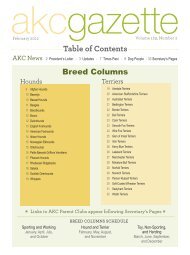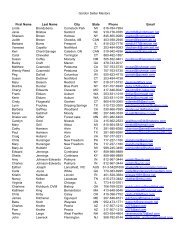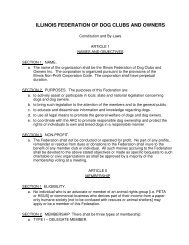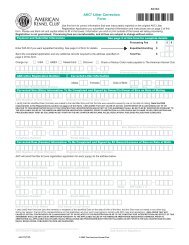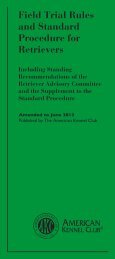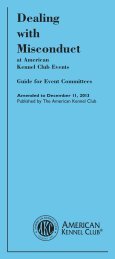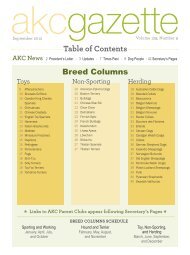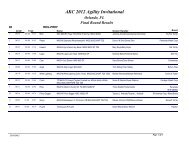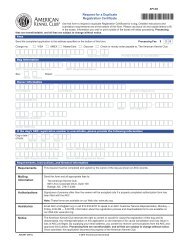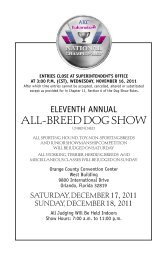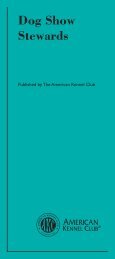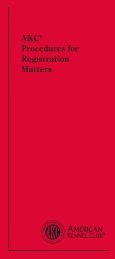Rules, Policies and Guidelines for Conformation Dog Show Judges
Rules, Policies and Guidelines for Conformation Dog Show Judges
Rules, Policies and Guidelines for Conformation Dog Show Judges
Create successful ePaper yourself
Turn your PDF publications into a flip-book with our unique Google optimized e-Paper software.
Certain breeds should never be sparred. Care must be<br />
taken to know which Parent Clubs do not want their<br />
breeds sparred.<br />
With a clear underst<strong>and</strong>ing of its present-day process<br />
<strong>and</strong> controlled application, it will be apparent that<br />
sparring is a safe, humane, appropriate procedure in<br />
the evaluation of Terrier breeds.<br />
Placing the <strong>Dog</strong>s A good way to group dogs <strong>for</strong><br />
your final decision is to rearrange them as they are<br />
examined <strong>and</strong> gaited. Once you have individually<br />
examined <strong>and</strong> gaited all of the dogs in a large class, it<br />
is best to excuse those not under consideration <strong>for</strong><br />
placement. In a very large class, you may have to sort<br />
out dogs through two or three eliminations. (Refer to<br />
Large Entries, Small Breeds) However, never reduce<br />
the number of dogs under consideration in a class to<br />
less than five, as one of the finalists may become lame<br />
or be excused <strong>for</strong> some other reason.<br />
Designating Class Placements Be especially careful<br />
in pointing to your placements. The best procedure<br />
is to align the class, putting the dogs to be placed<br />
in proper order at the front of the line. Do not make<br />
placements as the dogs are moving unless the dogs<br />
have been put in placement order.<br />
Once you have decided on the placements, indicate<br />
them clearly to the exhibitors, <strong>and</strong> direct them to the<br />
proper markers. Look at each armb<strong>and</strong>, <strong>and</strong> mark<br />
your book accordingly be<strong>for</strong>e you h<strong>and</strong> out ribbons<br />
<strong>and</strong> prizes. Keep each dog at the proper place marker<br />
until you award its ribbon.<br />
Best in <strong>Show</strong><br />
In judging Best in <strong>Show</strong>, you may mark the book<br />
be<strong>for</strong>e indicating the Winner. If you use this procedure,<br />
do not move the dogs again after marking the<br />
book.<br />
[R] Reserve Best in <strong>Show</strong> A Reserve Best in <strong>Show</strong><br />
must also be offered by any club giving group classes.<br />
The Reserve Best in <strong>Show</strong> winner will be chosen by<br />
the same judge that has been assigned Best in <strong>Show</strong>.<br />
The second place from the group in which the Best in<br />
<strong>Show</strong> winner advanced from WILL NOT be called into<br />
the ring <strong>for</strong> the selection of Reserve Best in <strong>Show</strong>. The<br />
judges book should be marked indicating Best in <strong>Show</strong><br />
<strong>and</strong> Reserve Best in <strong>Show</strong> at the same time.<br />
The Best in <strong>Show</strong> judge shall first announce Reserve<br />
Best in <strong>Show</strong>, followed by Best in <strong>Show</strong>.<br />
[R] Double Entries Once a dog has competed, it must<br />
continue to compete (Chapter 14, Section 1 of the<br />
<strong>Rules</strong>). <strong>Dog</strong>s may be absent from the first class <strong>and</strong><br />
still compete in the second class. However, dogs may<br />
not be shown in the first class <strong>and</strong> then be marked<br />
absent in the second class. Once defeated in any class,<br />
a dog is not eligible <strong>for</strong> Winners class.<br />
15




